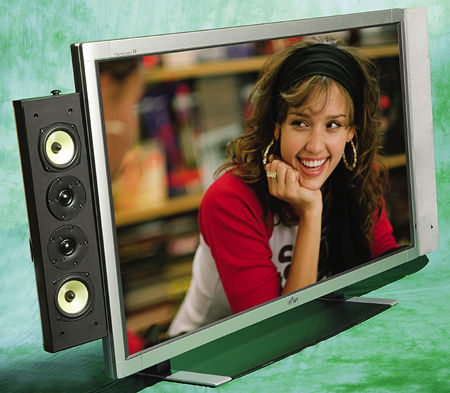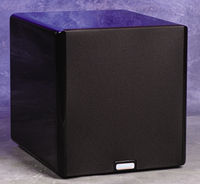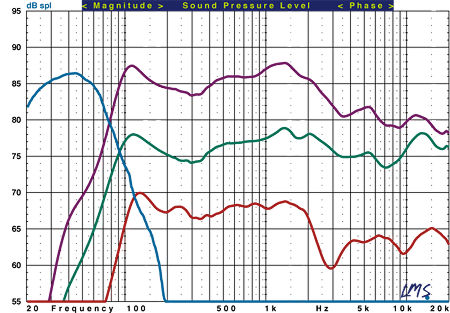Artison Portrait Speaker System, Velodyne DD-12 Subwoofer, and Fujitsu P55XHA30WS Plasma HD Monitor
by Chris Lewis
A voice for plasmas everywhere.
Choosing the perfect plasma is hard enough. Finding a complementary speaker system is an even greater challenge. Let Artison, Velodyne, and Fujitsu take some of the guesswork out of your purchasing decision.

I hear a lot of talk about plasma speakers these days. So far, it appears that the definition is being loosely applied. Sometimes the billing makes more sense, as with flat-panel speakers that you can also mount on the wall. Sometimes it can be a stretch, like any speaker that happens to be silver, small, or aesthetically pleasing. What I haven't seen, until now, are speakers specifically designed for use with a plasma screen, so much so that the set becomes an integral part of their logistics. Unless we want to return to something akin to the Hill Plasmatronic speakers of the 1970s (which produced sound with a form of plasma technology itself), Artison's new Portrait Series probably deserves the plasma-speaker moniker more than any other speaker system out there at the moment.
The Portrait Series is the newly founded company's first offering, but don't think that this is another fly-by-night company attempting to capitalize on a fad. Artison is the latest effort of seasoned speaker designer Cary Christie, who (among other things) cofounded Infinity Systems and was their principal designer for 25 years. He also designed Acoustic Research's successful Phantom Series a few years back.
 Artison's Portrait speakers set themselves apart by attaching directly to either side of a plasma's frame, via brackets and a custom grille kit that is specifically designed for each display model. Once mounted, these speakers are almost as seamless a part of the plasma as the $0.50 paper drivers in most CRT sets. The spatial and aesthetic benefits of this approach are obvious, but don't underestimate the major logistical benefits of not having to cut holes in your walls or install brackets just to have convenient speakers—and then doing it all over again when you move the display. Convenience and aesthetics don't often work hand in hand, but they clearly do here.
Artison's Portrait speakers set themselves apart by attaching directly to either side of a plasma's frame, via brackets and a custom grille kit that is specifically designed for each display model. Once mounted, these speakers are almost as seamless a part of the plasma as the $0.50 paper drivers in most CRT sets. The spatial and aesthetic benefits of this approach are obvious, but don't underestimate the major logistical benefits of not having to cut holes in your walls or install brackets just to have convenient speakers—and then doing it all over again when you move the display. Convenience and aesthetics don't often work hand in hand, but they clearly do here.
The Portrait Series currently consists of two models: an LCR and a surround. The LCR ($1,500/pair) is particularly interesting in its handling of the center channel, which is usually a major logistical headache in a plasma system. Rather than forcing an awkward mounting above or below the screen, Artison has eliminated the physical center-speaker cabinet altogether and incorporated a dual-mono center-channel design into the LCR models. This means that each LCR has two independent driver complements, each of which consists of a 4.5-inch Kevlar midbass driver and a 1-inch soft-dome Vifa tweeter. One driver complement handles front-channel duties, while the other handles center-channel duties. Each has its own binding posts and requires its own input. Supplied cables link the center-channel posts on the two LCRs so that only one center-channel signal is required from the amp.
Each LCR has a side-mounted tweeter that's designed to expand the soundstage beyond the speakers' physical location (which is obviously somewhat close together), as well as a center-channel presence control that allows you to adjust its output based on the room's relative reflectivity. Rear-panel switches control both. The LCR's aluminum cabinet measures a svelte 24 inches high by 6 wide by 3.5 deep. Optional stands to mount the LCRs as tower speakers are available.
The LRS surround ($500/pair) uses one 4.5-inch midbass driver and two 1-inch Vifa tweeters in a hybrid monopole/dipole design. Above 3 kilohertz, the speaker operates as a dipole for better diffusion of easily localized high-frequency elements. Under 3 kHz, it acts as a monopole. The surround is easily wall-mounted, comes in a black or white finish, and measures 9 inches high by 9.5 wide by 3 deep.
Artison has teamed up with Velodyne to offer a sub that's tailor-made for the Portrait speakers. The DD-12 sub ($2,999) uses a 12-inch driver backed by a massive 1,250 watts of RMS power. RS-232 ports are supplied, as are balanced, single-ended, and speaker-level inputs and single-ended outputs. The DD-12 is from Velodyne's Digital Drive Series, which stands out not only for being the first microprocessor-controlled, high-gain servo subwoofer system but also for offering a built-in equalization system complete with its own onscreen interface and calibration microphone. Visit Velodyne's Website for the full rundown, as I can hardly do it justice here. Trust me, though, it's impressive. The interface makes flattening in-room response as easy as adjusting a real-time frequency-response curve onscreen, and several presets and custom modes allow you considerable flexibility in adjusting parameters like low-pass crossover frequency and slope, subsonic frequency and slope, phase, polarity, and gain. A supplied remote navigates the onscreen system and makes quick adjustments a snap while listening. The system is highly intuitive—and highly effective.
With music, I immediately liked the blend I heard between the Velodyne sub and Portrait satellites. Clearly, two manufacturers have designed a system together here, rather than just slapping one together. Something like Pink Floyd's "Another Brick in the Wall" from the second Burmester collection tested the range from top to bottom. I heard clean, crisp highs from the Portraits and strong, controlled bass from the DD-12, and I couldn't hear any real gaps at the crossover point (stated as 70 hertz).
Both two-channel and multichannel music demonstrated that the Portraits can produce a much larger soundstage than you'd think. They filled our mid-sized room with a stable, well-defined stage that displayed a surprising amount of depth and separation. High-resolution material only helped this cause. High-frequency details like the harmonica work in Muddy Waters' Folk Singer (MCA, SACD) or the clarinet that dominates Bucky Pizzarelli's Swing Live (Chesky, DVD-Audio) were expectedly smoother and more natural in high resolution, and midrange performance remained solid throughout. The DD-12 did a nice job of filling out the bottom end of Swing Live (although there is no separate LFE track). The Portraits can handle more bass than many satellites, but you have to be realistic about what you can expect from a smallish woofer in a smaller cabinet. The DD-12 clearly has significant musical abilities; with the control you have over it, you can make it a real asset for music in this system—something you can't say about many subwoofers.
The DD-12 knows its way around a movie soundtrack, where it delivered deeply extended and powerful bass that shakes your gut without any real hint of distortion or monotone boom. Again, the control it provides strongly impacts its in-room performance, but even those who get lazy and dump it into a corner without making a single adjustment will be able to get away with it more than usual, thanks to the DD-12's quality design and execution.
Speaking of quality design and execution, the LCRs' center-channel system is just that. Not only is it effective in creating a stable, sizable center image (especially for listeners who aren't sitting too far off-center), but it more effectively creates the illusion that voices are coming directly from the mouths onscreen than most speakers mounted above or below the screen. The Portraits were again able to deliver considerably more stage presence than I expected from a system with no separate center, two fronts parked closer together than I'd normally recommend, and two small surrounds. This comes from good design—not smoke and mirrors or processing tricks—and the Portraits were successful with a wide range of soundtrack formats.
Even in the crowded and cutthroat waters of the speaker market, success can be as simple as having a quality product in the right place at the right time. Artison obviously knows this, and the Portraits are the result. This is the best solution I've seen so far for maintaining a plasma system's convenience and aesthetics in the speaker department. The Portrait ensemble provides significantly more performance than a system of this size, displacement, and even price would be expected to, and its logistical and ergonomic advantages make it truly deserving of the plasma-speaker badge.
Highlights
Artison / Velodyne Combo:
• Performance beyond their size and price
• Velodyne DD-12 is top-shelf in terms of performance and features

Portrait LCR Speaker $1,500/pair
Portrait LRS Surround Speaker $500/pair
Portrait LCR Mounting/Grille Kit $150
Artison
(775) 833-4344
www.artisonusa.com
Dealer Locator Code ART
DD-12 Subwoofer $2,999
Velodyne Acoustics
(408) 465-2800
www.velodyne.com
Dealer Locator Code VEL
HT Labs Measures: Artison Portrait Speaker System / Velodyne DD-12 Subwoofer

This graph shows the quasi-anechoic (employing close-miking of all woofers) frequency response of the Portrait LCR L/R (purple trace), DD-12 subwoofer (blue trace), Portrait LCR center channel (green trace), and Portrait LRS surround (red trace). All passive loudspeakers were measured at a distance of 1 meter with a 2.83-volt input and scaled for display purposes.
The Portrait LCR's listening-window response (a five-point average of axial and +/–15-degree horizontal and vertical responses) measures +1.31/–7.60 decibels from 200 hertz to 10 kilohertz. The –3dB point is at 88 Hz, and the –6dB point is at 80 Hz. Impedance reaches a minimum of 3.47 ohms at 330 Hz and a phase angle of –59.40 degrees at 59 Hz. Sensitivity averages 86.5 dB from 500 Hz to 2 kHz.
The Portrait LCR center's listening-window response measures +1.34/–4.10 dB from 200 Hz to 10 kHz. An average of axial and +/–15-degree horizontal responses measures +1.66/–3.57 dB from 200 Hz to 10 kHz. The –3dB point is at 87 Hz, and the –6dB point is at 77 Hz. Impedance for the pair in parallel reaches a minimum of 3.15 ohms at 318 Hz and a phase angle of –46.47 degrees at 139 Hz. Sensitivity for the pair in parallel averages 88.5 dB from 500 Hz to 2 kHz.
The Portrait LRS's three-face averaged response measures +0.78/–8.44 dB from 200 Hz to 10 kHz. The –3dB point is at 98 Hz, and the –6dB point is at 90 Hz. Impedance reaches a minimum of 3.45 ohms at 330 Hz and a phase angle of –64.97 degrees at 59 Hz. Sensitivity averages 85 dB from 500 Hz to 2 kHz.
The DD-12's close-miked response indicates that the lower –3dB point is at 23 Hz and the –6dB point is at 19 Hz. The upper –3dB point is at 66 Hz in the EQ Defeat mode.—MJP
- Log in or register to post comments






























































